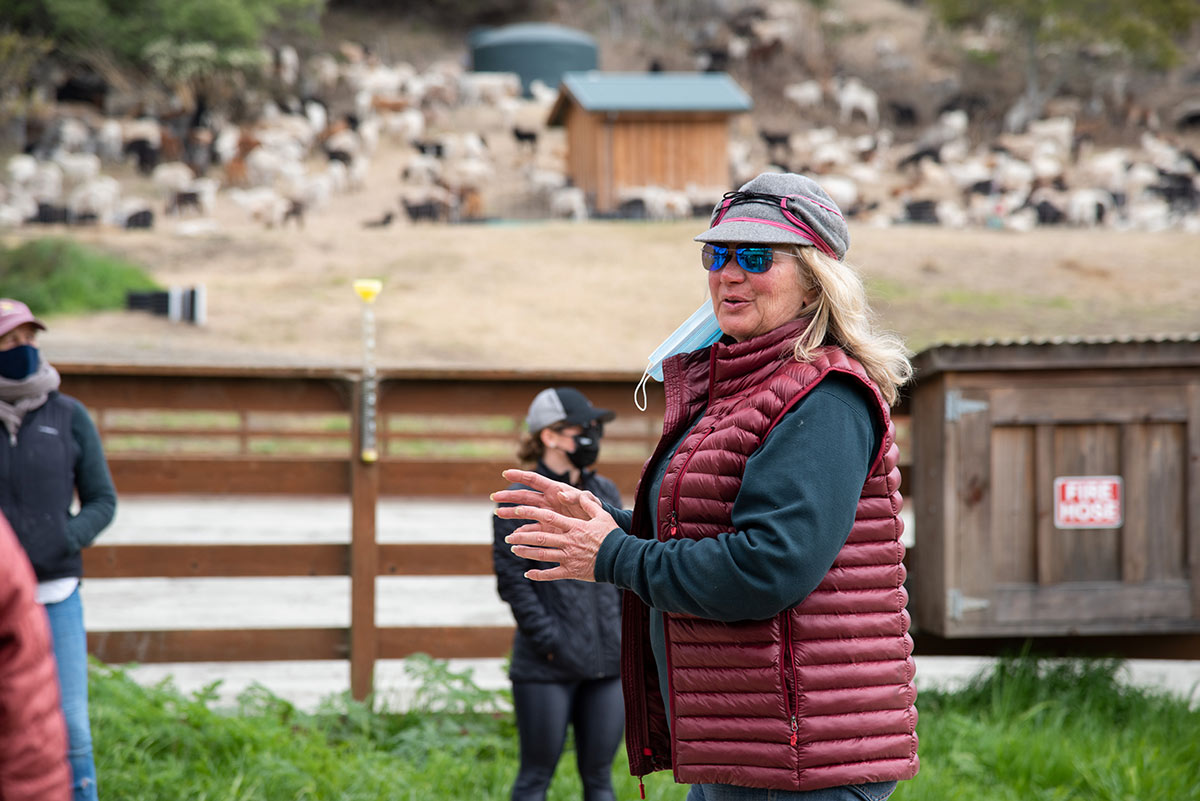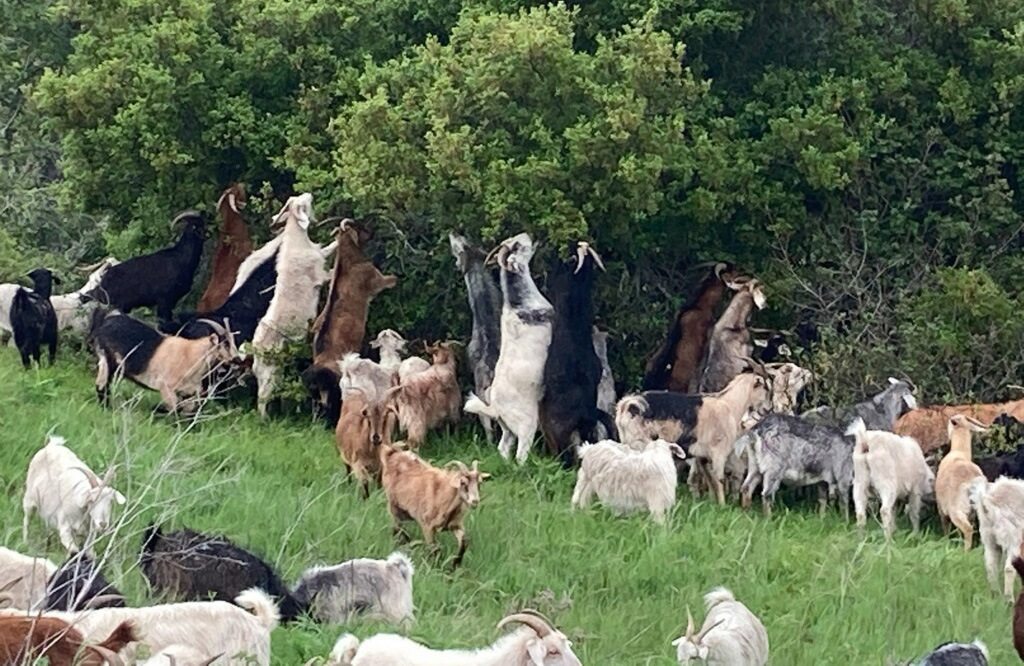Fire prevention has risen in importance over the past few years. This April, TomKat Ranch partnered with Lani Malmberg
An Interview with Goatapelli Foundation’s Lani Malmberg

Lani Malmberg, Executive Director of Goatapelli, describes how goats are uniquely suited to alter landscapes and mitigate fire risks to a group of visitors at TomKat Ranch.

04/30/2021
By: Celia Hoffman
Fire prevention has risen in importance over the past few years. This April, TomKat Ranch partnered with Lani Malmberg, founder, and owner of Goatapelli Foundation, a goat grazing service that uses managed goat herds as an effective, ecologically beneficial wildfire prevention tool.
Goats at TomKat Ranch
On April 6, approximately 850 goats arrived and immediately started grazing up the brush-filled hill behind the main barn and around the ranch buildings to create a fire break. Lani explains her job here is “Fire mitigation in an educational adventure with TomKat Ranch.” Neighbors came to see the goats and learn from Lani about how goats can decrease fire risk while promoting soil health.
Each day, goats eat three times their body weight and drink an average of 1 pint of water a day. Lani calculates her goats graze “about three tons a day on the forage fuel ladder.”
Lani Malmberg
At 33 years old, Lani enrolled in Colorado State University to study botany and plant biology as a single mother with no money. For a soil class project, Lani focused on Russian Knapweed, inspired by a summer experience where the weed took over a local cornfield. Her research connected her with an expert professor who offered her a research position with a stipend as part of a master’s degree in weed science. Although she had no idea what a master’s in weed science meant or would entail, Lani jumped at the chance, needing the stipend to take care of her two sons.
During graduate school, Lani worked on an ongoing research project studying ewe sheep. A rancher by background, Lani was shocked by her classmates’ lack of understanding of livestock management and found the project in a state of disarray. Determined to fix the project, Lani went to the dean and asked to take it over. He gladly agreed and allowed Lani to hire her two sons as college employees.
While studying the sheep’s eating patterns, Lani thought somebody ought to use animals to target the plant they want to get rid of. When Lani saw a goat for the first time, she knew that was the animal she needed to start a managed grazing company. In 1996, she bought 100 goats and started grazing in many western states. Traveling the country for grazing contracts ever since, Lani explains, “I’m the one that never quit.”
How do goats help with fire prevention?
Goats decrease the amount of fuel for wildfires by eating excess brush. They stand on their hind legs, reaching vegetation from the ground to 9 feet high, minimizing the fire’s ability to catch on low-hanging tree branches. Goats are browsers—they will eat almost any plant and tend to avoid eating grass, in contrast to cows and horses, which are grazers that prefer grass. Lani explains she has yet to find a plant that her goats will not consume as long as you know what time of year the goats will like the target plant. For example, goats avoid stinging nettle when it’s green, but later in the season, the goats eat the nettle happily.
Each day, goats eat three times their body weight and drink an average of 1 pint of water a day. Lani calculates her goats graze “about three tons a day on the forage fuel ladder.” The goats eat massive amounts of potential fuel and can travel where machines cannot. The goats run up steep hills, climb trees, and reach in narrow crevices, all while respecting the natural world around them. Lani explains, “If there was a bird’s nest [on the ground] the goat would step over it instead of into it.”

Goats can stand on their hind legs, reaching vegetation from the ground to 9 feet high, minimizing the fire’s ability to catch on low-hanging tree branches.
Why goats?
“The goats are doing fifteen things at the same time,” Lani explains. Beyond clearing the fire fuel ladder, they aerate the soil with their hooves, preventing erosion and building soil structure. Simultaneously, the vegetation the goats eat moves through their digestive tract and delivers accessible nutrients to the soil microbes. When goats lay down together, to sleep or chew their cud, their body heat warms the soil, helping seeds germinate.
Goats also work as an alternative to pesticides. Their teeth crush the seeds, preventing further spread of the targeted plant. Lani manages her goats to remove plants such as thistle and hemlock and to create space for native plants. Unlike a machine, Lani notes, the “goats bring a living energy into a landscape”. As they move across the land, they spread their joyful energy, eat shrubs, spread (natural) fertilizer, and aerate the ground. The goats are a part of “a living functioning system”.
Lani’s goats are twenty-sixth-generation grazers. They are experienced and trained in eating weeds and brush and can be contained by the electric fencing she sets up for them. Though the goats could jump over the fence any time, they trust Lani to move them to new vegetation when they are hungry.
How do goats improve soil health?
Maintaining healthy soils is critical for plant growth and increasing fire, flood and drought resistance. How does this work? As the herd moves across the ranch, 3,400 hoofs trample and aerate the soil, stabilizing the ground and building soil structure. Goats also build soil organic matter through their digestive system as they eat vegetation, Lani explains, “all of that plant material is recycled through their belly and put back in place as pure organic fertilizer and trampled into the soil”.
Working in partnership with nature
Lani strategically plans when and where her goats will graze to decrease the fire fuel ladder while distributing nutrients, avoiding over browsing. Working alongside the active animals, and understanding which plants her goats will eat, Lani explains, “The soils and the plants and the plant families, that’s science. The art is handling the animals. And the spiritual overlay is getting along with the mountain lions and the energy of where I am. It’s all balanced.”
Since coming to TomKat, five goats have passed away, three to a mountain lion and two to other natural causes. While sad to lose goats, Lani explains she and her herd entered an environment that is home to other animals. As a response to the mountain lion attack, Lani keeps the goats moving to stay out of the lion’s territory.
Fire Mitigation and Soil Restoration
TomKat Ranch is excited to be working with Lani this April to work on fire mitigation and soil restoration. We can now easily walk through a hill that previously presented a high fire danger due to the density of brush close to buildings. Goatapelli’s ability to achieve this goal while benefiting our ecosystem and nourishing hundreds of hungry goats is a win/win for us all.